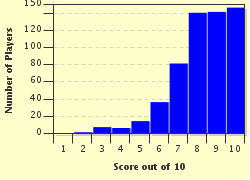Quiz Answer Key and Fun Facts
1. What is osteogenesis imperfecta more commonly known as?
2. Renal osteodystrophy is a bone disorder that is caused by which of the following?
3. Pneumoconiosis is a disease caused by canaries, and causes the human lung to turn into bone.
4. What bone disease is most commonly found in women over 60 years of age?
5. Marble Bone Disease causes the bones to become solid all the way through, causing a loss of which of the following?
6. Which bone is affected in infants suffering from craniosynostosis?
7. Acromegaly is a disorder that can cause many things and has which very noticeable effect on the bones of the patient?
8. Kyphosis is a disorder of which of the following bones?
9. Fibrodysplasia ossificans progressiva (FOP) is a very rare disorder which causes other connective tissues of the body to turn into bone.
10. Nail-patella syndrome is a genetic bone disorder that can result in many problems including poorly developed bones particularly associated with which joint?
Source: Author
dcpddc478
This quiz was reviewed by FunTrivia editor
CellarDoor before going online.
Any errors found in FunTrivia content are routinely corrected through our feedback system.

